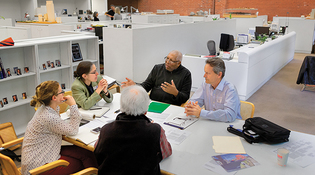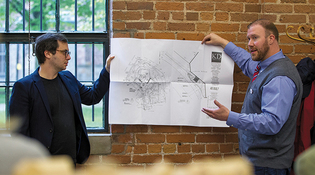 loading
loading
featuresDay of Service: Think before you sketchIn New Haven, alumni architects offered free consultations.  Bob HandelmanArchitects Marissa Mead (left) and Ioana Barac ’03MArch talk to Peter Fay and Clinton Gardiner ’78 (right) about the Newport project. View full image“You bring us your problems. We sit and talk about it. We try and find some direction, all in a couple of hours.” That was the agenda set by architect Craig Newick ’87MArch at the office of Newman Architects in New Haven on the morning of May 12. Representatives from four nonprofit organizations brought the problems; nine architects offered the direction. It was one of seven such consulting sessions, across the US and in Taipei and Singapore, under a Day of Service program called The Architect Is In. Peter Fay and Clinton Gardiner ’78 came to talk about their scheme to build a monument in Newport, Rhode Island, remembering those enslaved in the transatlantic slave trade. The city has given their group a small downtown park as a site for what they are calling the Newport Middle Passage and Port Marker Project, and now it’s time to figure out what to do next. “How do you get started on a project like this?” asked Gardiner. “How do you find a design and figure out how to build it?” The other nonprofits were the New Haven Ballet, which is looking to consolidate its many rented rehearsal spaces into a more convenient facility; The Towers, a New Haven senior housing complex wanting to make a place where people in wheelchairs could do some gardening; and the Tomaquag Museum in Exeter, Rhode Island, which is seeking a new, more accessible location. After introductions, the clients retired to different corners of the office, each with a couple of architects. Architects Ioana Barac ’03MArch, Marissa Mead, and Robert Orr ’73MArch sat down with Fay and Gardiner and started talking options: interview several architects and artists and pick one? Or have a design competition? To understand the project better, the architects said, Fay and Gardiner will want to have a site analysis done to see how people and cars move through the area. They might want to hire a facilitator to navigate some of the issues. And they’ll need to nail down a budget. (And God help them if utility lines have to be moved.)  Bob HandelmanJesse Wescott (right) of The Towers describes his garden project as AJ Artemel ’14MArch looks on. View full imageThe conversations went on for a couple of hours, but except in the wheelchair garden group, the architects never made a single sketch. The discussions were mostly about process, and the physical solutions will come further down the road. But the clients seemed happy. “Projects like this, which rely on volunteers, can get stalled,” said Gardiner when the groups all got together at the end. “We can now go back to the larger group and say, ‘We’ve got to do these three or four things’ and keep the energy going.” Added Fay: “It was all very nebulous when we got here. What we got was not what I expected: not a plan, but a lot of good advice.” The Architect Is In is now in its fifth year. Craig Newick has every expectation that the architects will be in again next year, providing more good advice.
The comment period has expired.
|
|